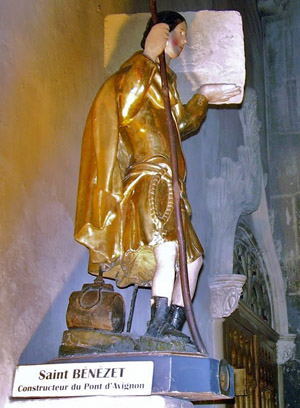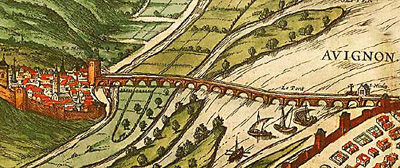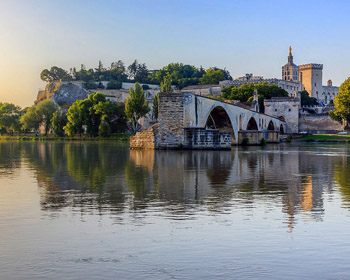 |
The Saint of the Day
St. Benezet of Avignon - April 14
Prof. Plinio Corrêa de Oliveira
Biographical selection:
Benezet, also known as ”Little Benezet” because of his stature, was a simple shepherd when he received a mission from Heaven. According the archives of Avignon he had a vision in 1177 and was told to build a bridge over the Rhône River in Avignon.
He knew he should go to the Bishop to inform him of this task. But since he only had three coins and had never left his village, he hesitated. Finally, he courageously set out for Avignon.

St. Benezet in Avignon Cathedral portrayed carrying the large stone |
The Prelate thought the man was mad and sent him to the Governor to be punished. The latter, irritated at his presumption, told Benezet that his mission was impossible: “How can you, a poor man with no knowledge or resources, build a bridge when neither God nor His Saints, and not even Charlemagne could do this? The Rhône here is quite impetuous. However, if you can take this enormous stone here in my palace and move it to the construction site, I shall believe your words.”
Benezet easily transferred the huge stone that 30 men could not move. With an expression of respect, the Governor kissed Benezet's hand and gave him the first 300 pieces of silver to begin the project. As news of this event spread through the area, donations started to pour in and many persons raised money for the Saint. The first stone of Avignon Bridge was laid in that same year of 1177 in the presence of the Bishop, who blessed it. The construction took 11 years.
During that time a confraternity of lay brothers was founded – called Brotherhood of the Bridge Builders or Pontiffs [pont in French means bridge; pontifs means bridge builder] – who help build the Avignon Bridge. Afterwards, they constructed others to facilitate the way for travelers, pilgrims and the poor. They sanctified their work by common prayer and had a chapel where they sang the office. St. Benezet, to whom God had given the gift of miracles, directed and helped them.
Once the Saint was in Bourgogne and the Devil turned over one of the pillars of the Avignon Bridge. Benezet immediately knew what had happened and returned to repair it.
St. Benezet died in 1184. He was buried on the bridge itself in a small chapel that was built on the Avignon side. His body remained there for about 500 years until 1669, when part of the bridge fell apart and was washed away. Then his remains were transferred to Avignon Cathedral.
In 1674 the coffin was opened and his body was found to be incorrupt and perfect; even the iris of his eyes conserved the natural color. The Archbishop of Avignon, followed by the nobility of the area, solemnly transported his body to the Celestine Church of St. Didier.
Comments of Prof. Plinio:
To understand the work of this Saint, it is necessary to consider the conditions of the Middle Ages. The whole system of roads inherited from the Roman Empire had collapsed. Also, with the medieval progress and expansion, the population had extended into many places of wilderness that the Romans had never reached. There was, therefore, a great lack of means of communication.

A monumental project to provide an easy road for pilgrims and travelers |
This deficiency obliged travelers to make long detours either on foot or horseback to reach many cities and villages. When the traveler would come upon a river, he had to cross it by means of small boats, which were often dangerous. Thus, to travel commonly involved inconveniences, disasters, as well as dangers because of bandits who assaulted the travelers. All these obstacles propitiated sin and disorder.
We understand, therefore, that Divine Providence wanted that situation to end and called a Saint specially to build the Avignon Bridge. Such a bridge would help to remedy the evils I just described. Rather than a purely practical aim, God used this bridge as a pretext to make known the soul of one of His Saints. It was in this scenario that St. Benezet appeared.
St. Benezet was a short man. The relationship between the stature of a person and his sanctity is curious. In a tall man, sanctity shines in harmony with the appearance of the person; there is a certain proportion between the grandeur of the soul and the stature of the body. In a short man, the grandeur of soul is disproportionate to the size of the body, and, for this reason, the grandeur of soul becomes more noticeable. It is said that the most exquisite perfumes are kept in small bottles. Many times this is true regarding men. Divine Providence, then, took a short man to make him shine as a great Saint.
Often God honors the humbler and more innocent stratums of the population and chooses His elect from modest and insignificant rural areas of a country. Such was the case of Benezet, who was chosen from a small village of France to build the great Avignon Bridge. The action of Divine Providence became patent in that extraordinary way.
God ordered the man to build a bridge but did not give him the means to achieve it. Many persons, who believe that God already provides everything needed when He calls someone to a great work, cannot understand this way of acting. But He did not want to rely on human means; He wanted to show that such a work did not depend on human strength. Thus, He ordered that poor short shepherd – who probably was not even a strong workman – to build the monumental Avignon Bridge.
So, Benezet went to present himself to the Bishop, who, as it often happens, did not listen to God’s voice but took an attitude of incredulity: “You? An emissary of God? Never!” And he sent him away to the civil authority to be punished for his pretension.

Only four arches of the original 22 remain on the famous Saint-Benezet Bridge of Avignon. |
The first inclination of the Governor was also to ridicule him. But a light sparkled in the soul of the Governor. So, in part from irony, in part from a sympathetic doubt, he gave the Saint an opportunity to prove himself: “If you are able to move this huge stone in my palace, I shall help you to build the bridge.”
Benezet replied without hesitation, “Very well.” And he went to that enormous stone and rolled it easily to the site of the future bridge. He, so small a man, could never do such a thing by himself ! By allowing that short man to roll that enormous stone, God made it evident that a miracle had occurred.
Then, we see the beautiful response of the Governor, who recognized the man of God, kissed his hand and gave the first donation for the construction of the bridge. Thenceforth the population helped him in this beautiful work where the Rhône River was conquered by the action of a Saint. The bridge was completed, men traversed it easily and prosperity came to the region without any form of revolution; it was the victory of the Saint.
This Saint continued to watch over his bridge. He was far away in another city when one of its pillars collapsed. He immediately returned and repaired it. It was the Devil who had tried to destroy the bridge. We can see the hatred of the Devil for works that promote true peace.
He died and was buried on his bridge. Could there be a more moving idea than to bury him there? On the very bridge he built? His body remained there for centuries, but after 500 years the bridge started to deteriorate.
Someone could say, "So, with this decay, where is his glory?” But this apparent failure was the occasion for his full glorification. The bridge's decay provided the occasion to transfer his body to another place and later to open his coffin. Then, everyone could see that his body was completely incorrupt. Thus, all of this led to his glorification.
When the very small and very poor are led by God on the path of failure, they can achieve magnificent works. As the Governor noted, “Neither God, nor his Saints, and not even Charlemagne could build that bridge.” But St. Benezet of Avignon could. This poor short man accomplished that extraordinary work.
Here you see another beautiful episode of the Middle Ages that could inspire a whole series of illuminations.


  |
|
Prof. Plinio Corrêa de Oliveira | |
The Saint of the Day features highlights from the lives of saints based on comments made by the late Prof. Plinio Corrêa de Oliveira. Following the example of St. John Bosco who used to make similar talks for the boys of his College, each evening it was Prof. Plinio’s custom to make a short commentary on the lives of the next day’s saint in a meeting for youth in order to encourage them in the practice of virtue and love for the Catholic Church. TIA thought that its readers could profit from these valuable commentaries.
The texts of both the biographical data and the comments come from personal notes taken by Atila S. Guimarães from 1964 to 1995. Given the fact that the source is a personal notebook, it is possible that at times the biographic notes transcribed here will not rigorously follow the original text read by Prof. Plinio. The commentaries have also been adapted and translated for TIA’s site.
|
Saint of the Day | Home | Books | CDs | Search | Contact Us | Donate

© 2002- Tradition in Action, Inc. All Rights Reserved
|
 |

|